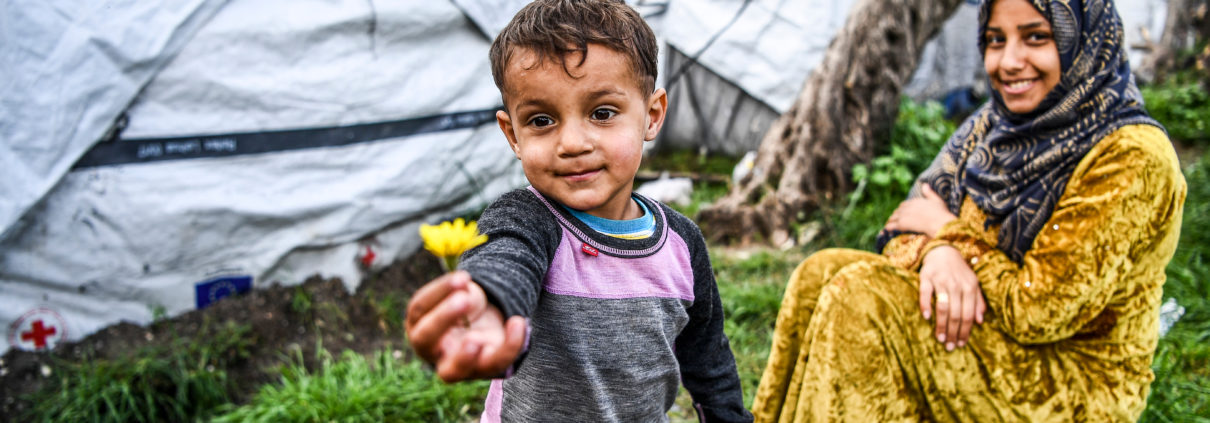The Caliphate’s Women and Children – What Role can the Family Courts play? (Part 1)
Publication by Dr. Rumyana van Ark for International Centre for Counter-Terrorism (ICCT-Hague)
Introduction
On 10 June, twelve French and two Dutch orphans of Islamic State fighters were repatriated from Syria to France. This followed the earlier repatriation of five orphans from Syria to France in mid-March of this year; a three year old girl whose mother was sentenced to life imprisonment in Iraq was also returned to France at this time. Norway, Belgium, and Australia have similarly followed suit. These are welcome developments after months (and years) of discernible reluctance by European states to facilitate the return of their citizens from Syria. Yet, thousands more women and children remain stranded in camps across Syria. Children with one or both parents still alive continue to face a perilous and uncertain future in these camps.
As the response to Shamima Begum’s dashed hopes of return to the United Kingdom (UK) aptly illustrates, public opinion remains hostile towards the prospect of the Caliphate’s men and women returning to their respective European countries. The rather cautious step of repatriating the “particularly vulnerable” orphaned children is a positive sign. Yet the questions of whether and how women and their children currently stranded in Syria should be repatriated remains. If states do begin repatriating women and their children more systematically, an array of additional questions arise: do these women pose a threat to national security? Could they be helpful in understanding the process of radicalisation? What has the impact on the children been? While these and other questions relating to the societal impact of returning women and children have been discussed at length, the role domestic family courts can play deserves more attention. The discourse surrounding the Caliphate’s women and children has been dominated by national security risk/threat considerations even when the well-being of a new-born child was at stake. Family law and family courts, regardless of the jurisdiction or circumstances, focus on the children, their families and what is in their best interests to preserve physical and mental welfare.
Family court decisions can be difficult to access, if at all, due to the sensitive nature of the issues involved. Nevertheless, the UK’s High Court Family Division has published, with redactions and abridgements, some decisions assessing potentially radicalised children and the possible risks posed by radicalised parents. The cases have ranged from children radicalised at home to children en route to Syria to children taken to Syria, with each case decided on its own merits. As such, there is no one overarching approach but rather a complex set of choices driven by a number of factors including the age of the child/children, the role played by a parent/parents, and the existing home environment and the possibility for de-radicalisation. At the core of each decision made by the Family Division have been the best interests and ongoing welfare of the child/children. So far, at least 150 to 160 similar cases have already been adjudicated on in the UK. The number is expected to rise as more and more women and children make their way back into the UK.
There are no publicly available statistics to suggest that the relevant courts in countries such as the Netherlands, France, and Belgium have dealt with a similar number of cases or adopted such a broad range of protective measures. From this perspective, the UK’s High Court Family Division could be seen as a trend-setter. Naturally, due to the differences in legal frameworks, family courts in other countries may not be able to adopt the same type of measures or proceed with similar interventions. Ultimately, however, all family courts are driven by the same core principles—the best interests of children and the protection of their physical and mental welfare. As the harm of radicalisation for children and radicalised parents is a new and rather challenging issue facing family courts across Europe, examining the fast-developing jurisprudence of the UK can be instructive. What the following discussion thus proposes to do is examine the more striking cases in order to illustrate the range of measures and interventions supported by the UK family courts in respect of returning and/or radicalised women and children.
Children radicalised at home
Before proceeding with an examination of the various cases, it is important to note a common thread among them—the role played by the respective . Under the Children Act 1989 and the Counter-Terrorism and Security Act 2015, Local Authorities in the UK have dual duties. The former impose a general duty to safeguard and promote the welfare of children in need. The latter obligations, which are quite specific to the UK, require the Local Authorities to have “due regard to the need to prevent people from being drawn into terrorism”. In other words, Local Authorities have a statutory role and responsibility in countering terrorism and helping protect vulnerable individuals from the risk of radicalisation. As illustrated by the cases below, the relevant Local Authorities have shown a strong commitment to their dual duties with swift and decisive actions taken in a number of cases. To protect the identities and addresses of the families involved, the names of the children, their parents, and most Local Authorities have been anonymised throughout the openly published decisions.
One of the first cases of its kind to reach the Family Division was London Borough of Tower Hamlets and B. In the first of a trio of cases, B was a sixteen-year-old teenager at the time of the hearing. On 6 December 2014, she was reported missing by her mother who was concerned that B had decided to travel to Syria. The Metropolitan Police Service Counter Terrorism Command intercepted the flight B was travelling on minutes before it was due to take off and removed her. After she was interviewed, the Local Authority applied to make B a Ward of Court. Under a Warship Order, in broad terms, the High Court becomes the legal guardian of a child. The application was granted and a number of measures were imposed such as use of certain software to monitor B’s online activity; in addition, the parents were asked to surrender both B’s and their passports to their solicitor. While B made no further attempts to travel, on 12 August 2015 her parents and siblings were arrested on suspicion of “possessing information likely to be useful to a person committing or preparing an act of terrorism”—an offence contrary to Section 58 of the Terrorism Act 2000.
During the second case, the materials found in the house were described as “not merely gratuitously shocking [but also] involving information of practical nature designed to support and to perpetrate terrorist attacks”. Having assessed the family situation, the judge in the case—Hayden J —concluded that B had been subjected to serious emotional harm and, at the very least, remained at risk of such harm in her parents’ care. In other words, her psychological, emotional, and intellectual integrity could not, at present, be protected within the family home. As such, only a safe and neutral environment away from her family would, for the time being, secure her welfare interests. The Local Authority’s proposal to place her in foster care was approved. In reaching this conclusion, Hayden J compared sexual abuse (or violations to the body in general) to the harm of radicalisation (or violations of the mind). He described the latter as every bit insidious and involving harm of similar magnitude and complexion.
In the third case involving B, the court was tasked with assessing whether B should remain separated from her family. The key questions within these proceedings were: had her parents played a role in her radicalisation? Have the other children in the family been radicalised or are they currently at risk? And, how should B’s and her siblings’ welfare be most effectively secured? In respect of the first question, the court found that both parents had played a role in her radicalisation. Hayden J scathingly noted that “none of the family members has given evidence which can be properly characterised as ‘the whole truth and nothing but the truth’.” The father, in particular, was deemed to have fundamentally failed to protect his children from viewing the gruesome images. Further, though perhaps he had not fully appreciated it, the father was found to have been complicit in “the corruption of his daughter’s emotional integrity and a corrosive influence on the development of her personal autonomy”. While B had become radicalised, no evidence was found that her siblings had followed her path.
Thus, the final question remained—should B continue to be separated from her family? B was found to still be radicalised and desensitised to human suffering. In using strong and emotive language, Hayden J stated that “having damaged such a crucial part of her core humanity, she must be regarded as a significant risk of harm to herself and others”. However, it was not the court’s role or objective to de-radicalise her but rather offer her the space and stimulation to open her mind to alternative possibilities. As a brief side note, a goal of de-radicalisation is arguably the encouragement of critical thinking allowing for the opening of a mind to alternative possibilities; however, perhaps, the judge in the case wanted to make a distinction between active engagement in de-radicalisation processes (not within the court’s purview) and facilitation of subsequent de-radicalisation activities post judicial proceedings. As for B’s particular situation, due to the complexities of her welfare needs, opportunities for appropriate foster care were practically non-existent. As a consequence, she lived for nine months in very isolated circumstances. During this time, it was not possible to provide her with the level of tuition she required and as a result she abandoned secondary school education.
Thus, the present arrangements were found to neither address the issues B faced nor to meet the range of her welfare needs to a satisfactory degree. The conclusion was to return B to her family home. While this may not seem as the most obvious or logical solution, in the particular circumstances of the case, Hayden J felt that B was most likely to rediscover her own intellectual autonomy in a home environment where she was happy and loved. A number of conditions were imposed on the family in order to facilitate the return—for example, B had to enrol in a local school rather than be home schooled. The mother, who had been described as “very controlling and involved”, was prohibited from attending her children’s Prevent sessions. Further, as emphasised by the court, it was easier for the police and social services to monitor the family if they were together.
Concluding Remarks
A number of important points can be drawn from this trio of cases. While the challenges of radicalisation may be a new facet in child protection, the court demonstrated willingness to act as often as required in order to safeguard the welfare of a child. Quite notably, the court showed extensive concern not just for B herself but also for her siblings and requested wide-ranging fact-finding on the family environment and impact assessment of the parents’ behaviour on all of their children. In each of the three cases, the court carefully considered how the siblings were coping and whether they also required protective measures. In other words, in recognising that the harm of radicalisation can be complex and multifaceted, the court adopted a holistic approach in respect of all siblings. Had there been evidence that one or more of the siblings was radicalised or at risk of radicalisation, the court would have been willing to impose additional protective orders. This should not be seen as judicial activism or too much of an interventionalist approach but rather a sign that the family courts are undeterred by the complexities of cases involving radicalisation and will act if deemed essential and proportionate in order to protect children from harm.
One of the benefits of family court involvement in such cases, is the judicial willingness to review the measures imposed as regularly as considered necessary and make adjustments if appropriate. In all of B’s cases, the facts as presently available were one of the deciding factors in reaching a conclusion. When circumstances dramatically changed and/or the impact of certain protective measures became more concrete, the court was prepared to adapt and adjust the orders imposed on the family. Underlying all of the considerations was the question of what is best for B’s welfare at a particular point of time. In other words, the court took a highly individualised approach towards B to ensure that the harm caused by radicalisation does not leave a more permanent mark. This individualised approach combined with deep sensitivity towards the complexities of radicalisation and appreciation for the importance of family unity, can be seen in cases such as Brighton and Hove City Council and The Mother and Y and A Local Authority and HB (mother) and MB (father) and ML and BL (The Children).
Overall, while direct engagement with de-radicalisation efforts is not within the purview of family courts, they can nevertheless facilitate de-radicalisation efforts post judicial proceedings through the type of child care measures recommended based on the facts of the particular case and the specific welfare needs of a child. In short, the family courts can play a very important role in reducing the risk and harm of radicalisation in respect of children. The subsequent cases involving children en route to Syria and children taken/born in Syria support this view. These cases will be discussed in Part 2.
About the Author
Dr. Rumyana van Ark (née Grozdanova) is a Research Fellow and a Coordinator at the International Centre for Counter-Terrorism – The Hague. She is also a Post-Doctoral Researcher in Terrorism, Counter-Terrorism and International Law at the T.M.C. Asser Institute within the Research Strand ‘Human Dignity and Human Security’. Her work focuses on the impact of counter-terrorism measures on the individual terror suspect and the long-term implications for the rule of law.
Courtesy ICCT-Hague



